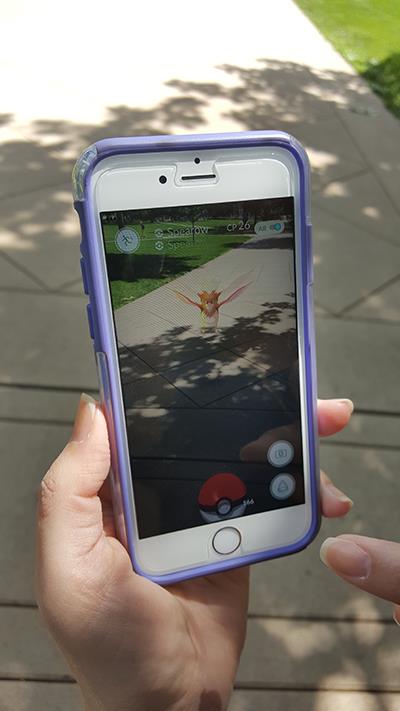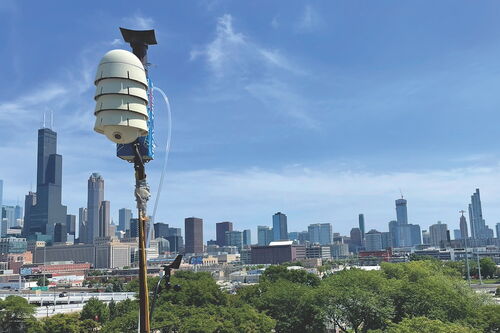Pokemon Go hits the Quad

If someone had asked the great artist Loredo Taft, creator of the Alma Mater, what people would call his iconic statue in the year 2016, it's safe to say that the words Pokegym never would have crossed his lips.
Even a month ago, few people could have foreseen how the Pokemon Go craze has hit campus, with Alma, the Eternal Flame, and scores of other campus landmarks being drawn into the augmented reality game as Pokegyms, Pokestops, and more.
The Quad has been busy lately with scores of players, eyes on their smartphones, firing virtual Pokeballs at virtual creatures as they go about their day.
Confused? So is just about everyone until they try it. Skeptical? You're not alone, but an LAS professor believes certain aspects of Pokemon Go have staying power in today's world.
"It's wonderful to think that we now have people walking about to play Pokemon Go, rather than gaming in the basement like a cliche," said Daniel Steward, a professor of sociology at Illinois who studies technology and society. "Mobile computing that makes gaming a matter of mobility has a great upside here. We can't pretend that people are less connected than they are, and we should celebrate these innovations."
Through Pokemon Go, users can collect and battle all 151 original Pokemon characters by walking around until one shows up on their phone screen. The smartphone app, developed by the Pokemon Company and Niantic, relies on Google Maps technology to populate the world with Pokemon and place Pokestops by local landmarks.
Pokemon games date back to the 1990s—albeit none like this—which may partly explain why the new game is so popular on campus. Most college students of today grew up with the series, whether through playing the games, watching the animated TV show, or both.
"I think there's a big nostalgia factor to it," said Conner McDonald, a junior in communication. "I don't think this would have worked quite as well with different subject matter. Everybody can identify with Pokemon and it's something that everybody here shares in common."
Nostalgia is part of what Steward called "a perfect storm" of factors leading to the game's immense popularity—including connections among companies with a hand in the game (namely Pokemon, Nintendo, Niantic, and Google).
"There are surely X-factors and good old-fashioned luck in the diffusion of innovation," Steward said. "That said, some times and places are more ripe than others. Mobile devices, the internet, common standards for GPS and UTC (Coordinated Universal Time), social media, and gaming are all converging in ways that make augmented reality codes and practices more and more viable."
Nearly three weeks after its release, Pokemon Go has shown few signs of slowing down. SurveyMonkey Intelligence, an app analytics company, estimated more than 20 million smartphone users play the game every day in the U.S., let alone the 27 other countries in which the game has been released thus far. Pokemon Go has been the most-downloaded app in the iOS App Store since July 6, the day it was released.
The sprawling campus at Illinois is a perfect place to play the game, with students and others taking advantage of their daily treks to take part. Pokemon Go rewards those who move—it can take more than six miles of walking to hatch a Pokemon egg, and add a character to your inventory.
"(Pokemon Go is) new and different and I think that's why everyone likes it," said Josh Zhang, a junior in molecular and cellular biology. "You have to walk around to actually catch any new Pokemon. I always go back to that childhood experience of catching Pokemon, evolving Pokemon. It's just a really fun time."
Steward believes the increased popularity of mobile games will necessitate a societal acknowledgement of how the world is changing. Virtual creatures are among us now, and the public must discuss how to move forward with augmented realities.
"We need to cultivate gaming in a manner that enables us to share public spaces and interact safely and sanely with strangers," Steward said. "Augmented realities, unlike virtual realities, depend heavily on coordination with the limited resource of our physical reality. How will we negotiate this?"
Others speculate that response to the game will die down, or evolve. Zhang said he had doubts about whether the craze will remain this popular for long.
"I think it's definitely going to drop off in popularity," Zhang said. "The people who designed Pokemon Gg, they're going to be adding new features to be excited about, but I don't think it will generate the same headlines it did in its first week.
Steward, however, said the technology that makes Pokemon Go possible could have a much bigger impact, such as in the world of education.
"Augmented realities are an intriguing framework for thinking about higher education," Steward said. "Imagine students gathering on the Quad for Socratic dialogues with an avatar of Socrates himself.








